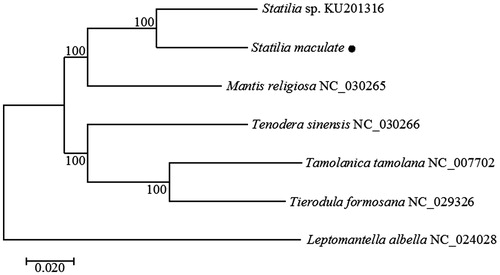Abstract
The complete mitochondrial genome of the Statilia maculate has been amplified and sequenced in this study. The mitogenome was 15,775bp long with two ribosomal RNA genes, 26 transfer RNA genes, 13 protein-coding genes, and a non-coding control region, with an A + T-rich characteristic (75.8%). Five identical tandem duplication of trnR were found in mitogenome of S. maculate, similar to the other mantis. According to the phylogenetic analysis, S. maculate had a closer genetic relationship with Statilia sp.
Statilia maculate (Thunberg), which belongs to Statilia of Mantidae of Mantodea, is a kind of important predatory insect and medicinal insect. The dry ootheca of S. maculate, which is named as Chang Piaoxiao, is very popular for Chinese medical resources. Chang Piaoxiao, which has significant effect on securing essence and reducing urination, enriching the kidney, and strengthening Yang-qi, is traditionally used to treat frequent micturition and seminal leakage (Committee Citation2015). Despite its useful applications, there is little report about S. maculate, except for its biological characteristic (Lin et al. Citation2008) and pharmacological study (Tan et al. Citation1997). In this study, we characterized the mitogenome sequence of S. maculate, and the sequence had been deposited in GenBank with accession no.KX900484.
The specimen was collected from Chengdu University of Traditional Chinese Medicine (30°58′12′′N, 103°48′36′′E) in Chengdu city, Sichuan province, China and identified as S. maculate based on its morphometric features and DNA barcoding technology. The sample used in this study was with Animal Ethics approval for experimentation granted by Chengdu University of Traditional Chinese Medicine, and was deposited in the herbarium of Chengdu University of Traditional Chinese Medicine (voucher ID:wjtl-2). The complete mitogenome of S. maculate is 15,775 bp in length, and contain 13 protein-coding genes (PCGs), two rRNA genes, 26 tRNA genes, and a non-coding control region, with an A + T-rich characteristic (75.8%). This kind of base composition bias is in agreement with other mantises with complete mitogenome reports (Tian et al. Citation2015; Ye et al. Citation2016). Eight of the 13 PCGs have ATN as the start codon, while COI utilize TTG, ND1, and ND5 start from AAT, ND4 translate from TCA, and ND4L start with TTA. Eight of the 13 PCGs terminate with incomplete stop codon (T/TA), and COI, ATP8, ATP6, COIII, and ND6 stop with complete TAA. In 13 PCGs, the longest one is ND5 (1695bp) and the shortest one is ATP8 (159bp).
Five identical tandem duplication of trnR were found in mitogenome of S. maculate. This phenomenon is consistent with the other praying mantis (Ye et al. Citation2016), which suggested mitochondrial tRNA of Mantodea exhibited high evolutionary diversity.
The phylogenetic analysis of six Mantodea species was performed using neighbour-joining algorithm based on the whole mitogenomes in MEGA7 (). The result further confirmed that S. maculate had a closer genetic relationship with Statilia sp. than other species of Mantodea.
Disclosure statement
The authors declare no any conflict of interest in the preparation and execution of this manuscript.
Funding
This work was supported by National Natural Science Foundation of China under Grant No. [81541167] and Science and Technology Development Fund of Chengdu University of Traditional Chinese medicine under Grant No. [030029140].
References
- Committee NP. 2015. Pharmacopoeia of the People’s Republic of China. Part 1. Beijing, China: Medical Science Press.
- Lin LL, Zhu F, Niu CY, Lei CL. 2008. The study of the biological characteristic in different geographical populations of Statilia maculate (Thunberg). Central China Studies of Insects. 5:127–133.
- Tan ZHH, Lei YL, Zhang BJ, Huang LY. 1997. Comparison of pharmacological studies on Ootheca Mantidis. Chin J Chin Materia Medica. 22:496–499.
- Tian XX, Liu J, Cui Y, Dong PZH, Zhu Y. 2015. Mitochondrial genome of one kind of giant Asian mantis, Hierodula formosana (Mantodea: Mantidae). Mitochondrial DNA. doi: 10.3109/19401736.2015.1106519.
- Ye F, Lan XE, Zhu WB, You P. 2016. Mitochondrial genomes of praying mantises (Dictyoptera, Mantodea). Sci Rep. doi:10.1038/srep25634.

